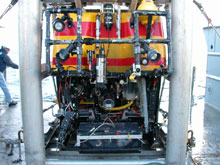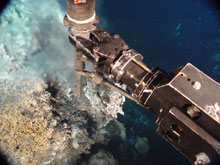The ROPOS Remotely Operated Vehicle
Bill Chadwick
Oregon State University
NOAA Vents Program
Last year, our 2003 Submarine Ring of Fire expedition involved mapping from the surface or towing sensors through the water. We surveyed over 50 submarine volcanoes in the Mariana Arc to see whether or not each was hydrothermally active. Sea-floor hot springs were detected at about 10 of the volcanoes by telltale thermal, optical, and/or chemical signals. This year we plan to get down to the bottom and actually explore these sites on the sea floor.
During the 2004 Submarine Ring of Fire expedition, our primary observation and sampling tool will be a deep-sea remotely operated vehicle named ROPOS (short for Remotely Operated Platform for Ocean Science). Remotely operated vehicles (ROVs) are unoccupied, highly maneuverable underwater robots that are lowered on a cable and are operated by a pilot aboard a ship at the surface, The cable provides power and communication to the vehicle and also allows live video and other data to be sent back up to the ship. The pilots at the surface also control the vehicle's manipulator arms to take samples or deploy instruments.
Main ROPOS Tasks and Tools
We will be making ROV dives at some of the volcanoes that were found to be hydrothermally active last year. The main tasks for ROPOS during these dives will be to (1) locate hot springs on the sea floor and determine their character and extent, (2) examine the biological community around each vent site for species that are only found at sea-floor hot springs, (3) investigate the physical setting of the vents to help us understand why they are located where they are and how long the site has been active, (4) sample the hydrothermal fluids for chemical and microbiological analysis, and (5) map the sites so we can determine the volcanoes' recent history and how it relates to the vent sites. In some areas we will also be making dives to “ground truth” some of the sonar mapping data we collected last year. Making direct observations on the sea floor in areas where the sonar data is enigmatic can help us to better interpret the mapping data in other areas.

The front of ROPOS on deck just before deployment. Many of ROPOS' tools can be seen in this image. Click image for larger view.
Some of the ROPOS tools that will be most critical for these tasks include the color video camera and the 5 megapixel digital still camera (for making direct observations of the sea floor), the hot fluid sampler (for taking samples of hot- spring fluids), push cores (for sampling loose volcanic materials on the sea floor), and the biobox and slurp sampler (for collecting biological and geological specimens). The most valuable ROPOS tool is perhaps the simplest: the "eye" that allows us to see what's down there as we explore the sea floor.
Visit the technology section of the Ocean Explorer Web site for more information on the ROPOS ROV.




























